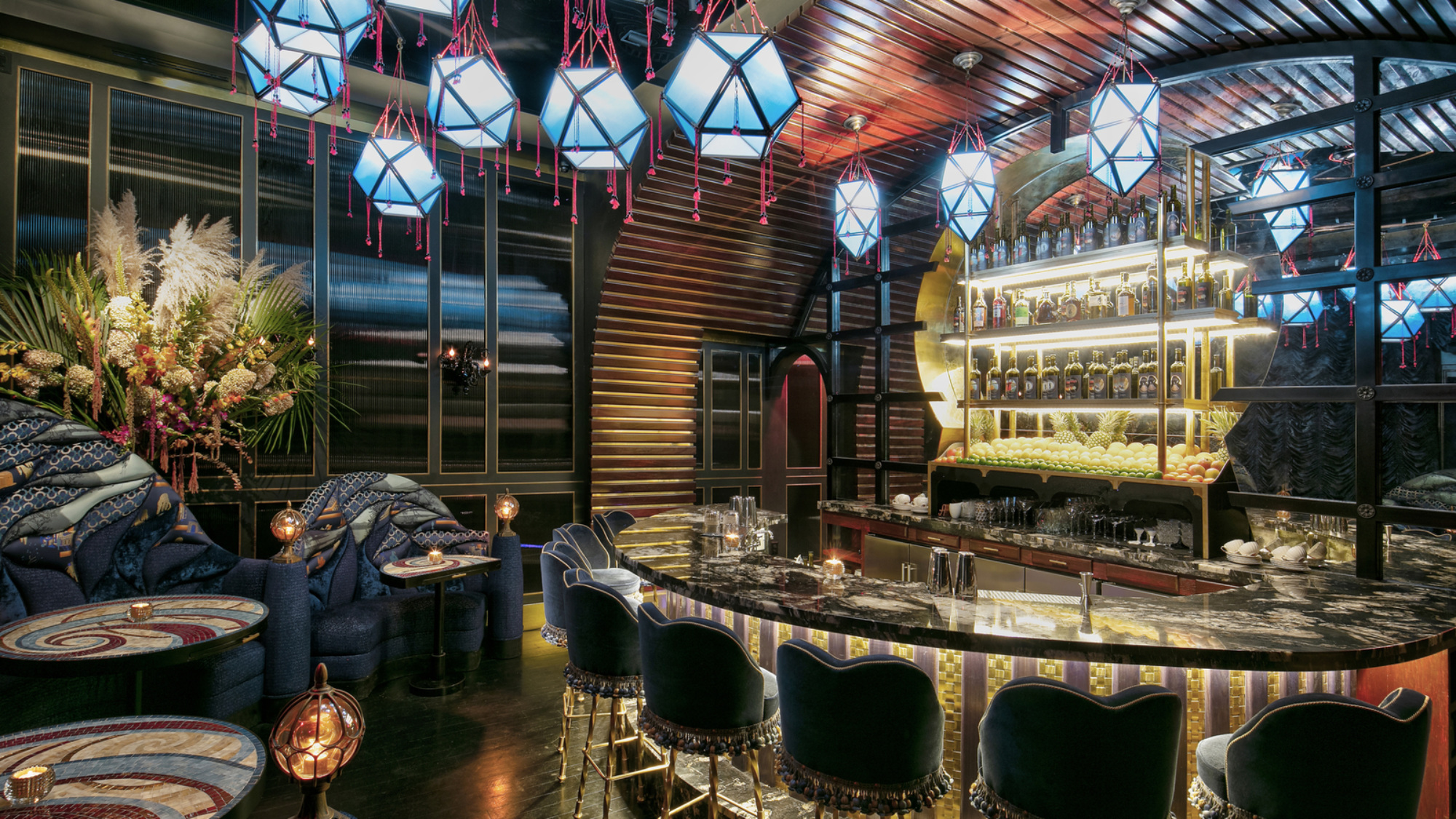
How the Team Behind New York’s Shinji’s Perfects Classic Cocktails
The nine signature cocktails that you’ll find at Shinji’s, an intimate 18-seat Flatiron cocktail bar from the same team behind Michelin-starred sushi specialist Noda, are not like the other drinks you’ll find in town.
They stand out for a number of reasons, the first of them being that all of them are, more or less, pre-batched or mostly made before you even place your order — minus the addition of any citrus.
Each pre-batched cocktail comes in its own bottle with its own custom label that relates to the story behind the drink, and the team uses an ultrasonic homogenizer — essentially a very fancy jewelry cleaner that emits ultrasonic waves — to blend the drink ingredients together with alcohol.
Why do all this? Because doing so ensures consistency, and it makes getting you that drink that much easier — and quicker. Solving for efficiency and aiming for perfection is an overarching goal for the team behind Shinji’s, operations director Philip Dizard and beverage director Jonathan Adler. Just don’t call it molecular gastronomy, they say. Talk to them about the drinks recipes they’ve developed over the last year and you’ll notice a common theme: wanting to transform classic cocktails into the very best possible version, or Platonic ideal, they can be.
“The mojito should taste like a mojito, the White Russian should be identifiably and objectively upon presentation without any context, identifiable as a White Russian, and it’s the same thing with the Screwdriver,” explains Dizard. “It’s the same thing with our dirty martini. These are ideas that you are intimately familiar with, everyone has had one of these cocktails. But no one has ever had one of these cocktails the way that we make it.”
Here’s a closer look at how they do just that, drink by drink, in Dizard and Adler’s own words.

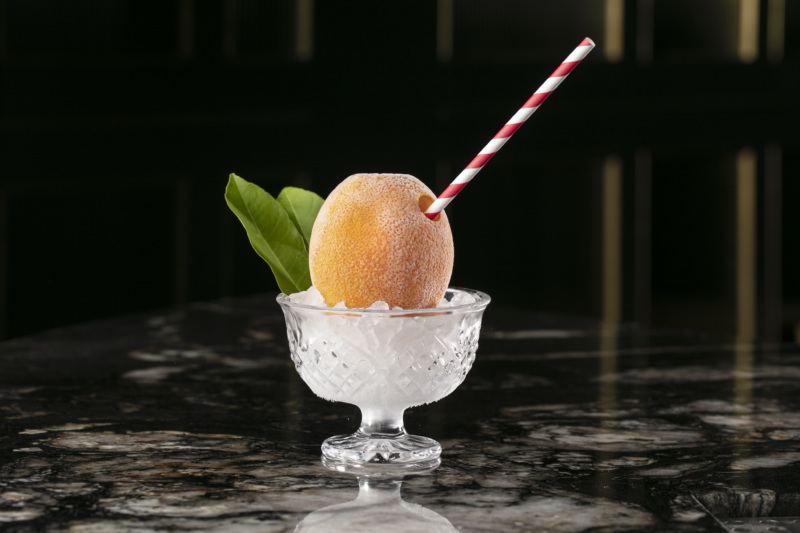
1. Tropicana
“I’ve been making drinks long before I could even see over a bar,” says Dizard, “and the first cocktail in my memory I’ve ever made was essentially a sundowner for my parents, who were about to go for a walk, and it was a screwdriver: vodka and orange. There was an ad from childhood from Tropicana orange juice where someone takes a red and white straw and sticks it into a real orange. I always had in my imagination that it could taste something slightly different; like it would be the best, most nuanced, most delicious orange juice you could ever imagine.
“Orange juice is kind of one of the white whales of the cocktail world. We don’t see many cocktails with orange juice in it, because it has a lot of sugar, and a kind of a lack of acidity, which is vitally important when constructing cocktails. With this drink I love exploring my own personal narrative and the narratives that we relate to from our childhood, but also solving what we’re addressing as a kind of perceived inadequacy in a cocktail.”
Adler adds, “When someone orders this, we come over and we place a red-and-white straw in front of them. And then we present them a glass goblet with crushed ice, with a real orange in it with citrus leaves that actually come from a local citrus producer in New Jersey called Kazumi Growers. I ask them if they remember watching that ad, and then I just tell them, ‘Well, now you get to take this red-and-white straw, and push it through this real orange and find out what it tastes like.’
“These oranges take roughly about six hours to make; they’re real oranges and we cut the bottom of them. We hollow them out and then we fill them up with a water balloon and fill that with water. Water freezes from the outside so, depending on the size of the orange, it takes about three-and-a-half hours to four-and-a-half hours to create a half-inch thick ice sphere inside. We’ll cut the bottom of the balloon. So, it retracts back, and we punch a little hole out near the top and save that. We’ll take a soldering iron and push it through the ice to drain out the liquid. And then when we make the cocktail, we’ll shake it up, pour it back inside, put the plug back in, and then you get to have that wonderful experience that you thought could never be possible.
“The formulation of the drink is certainly more complex than just vodka and orange juice. Incidentally, it involves a mango-infused scotch and an orange liquor which we make in house. We use large navel oranges, which we found have the most uniform and largest capacity out of any orange that we’ve used.”
2. Jackie Treehorn
“This is [based on the character of the same name from the movie, The Big Lebowski],” says Adler. “I think people who really enjoy that movie and movies in general enjoy the very meta detailed references that this drink has.
“It’s a White Russian, but there’s no dairy, no dairy substitutes, and no nut milk, oat milk, soy milk, none of it whatsoever, but it tastes exactly like what you would expect the best White Russian possible to taste like. The coaster we use is a oriental rug. The glassware we use is made by Jonathan Adler and it’s these beautiful black and white glasses. And then the drink itself is made from vodka that’s infused with both coffee beans and vanilla.
“Because Jackie Treehorn’s mansion was in Malibu, I immediately thought of Malibu Rum, which is coconut rum. So, we make a syrup with toasted coconut and there’s a little bit of maple syrup to add some sweetness and body. And we basically put all the ingredients in a blender. We add the same amount of lactic acid that you would find in whole milk to give it the same texture, acidity, and mouthfeel as milk. And we stream in some oil and bind it with xanthan gum and then homogenize it. So it’s basically fancy salad dressing. It’s a lot healthier than drinking a big glass of milk, but it’ll taste exactly like what you would expect a White Russian to taste like. And then over the top we add a housemade candy made of pecan, coffee, and coconut. And then the label for the bottle is a silhouette of The Dude with the sunglasses, in front of a bowling lane.
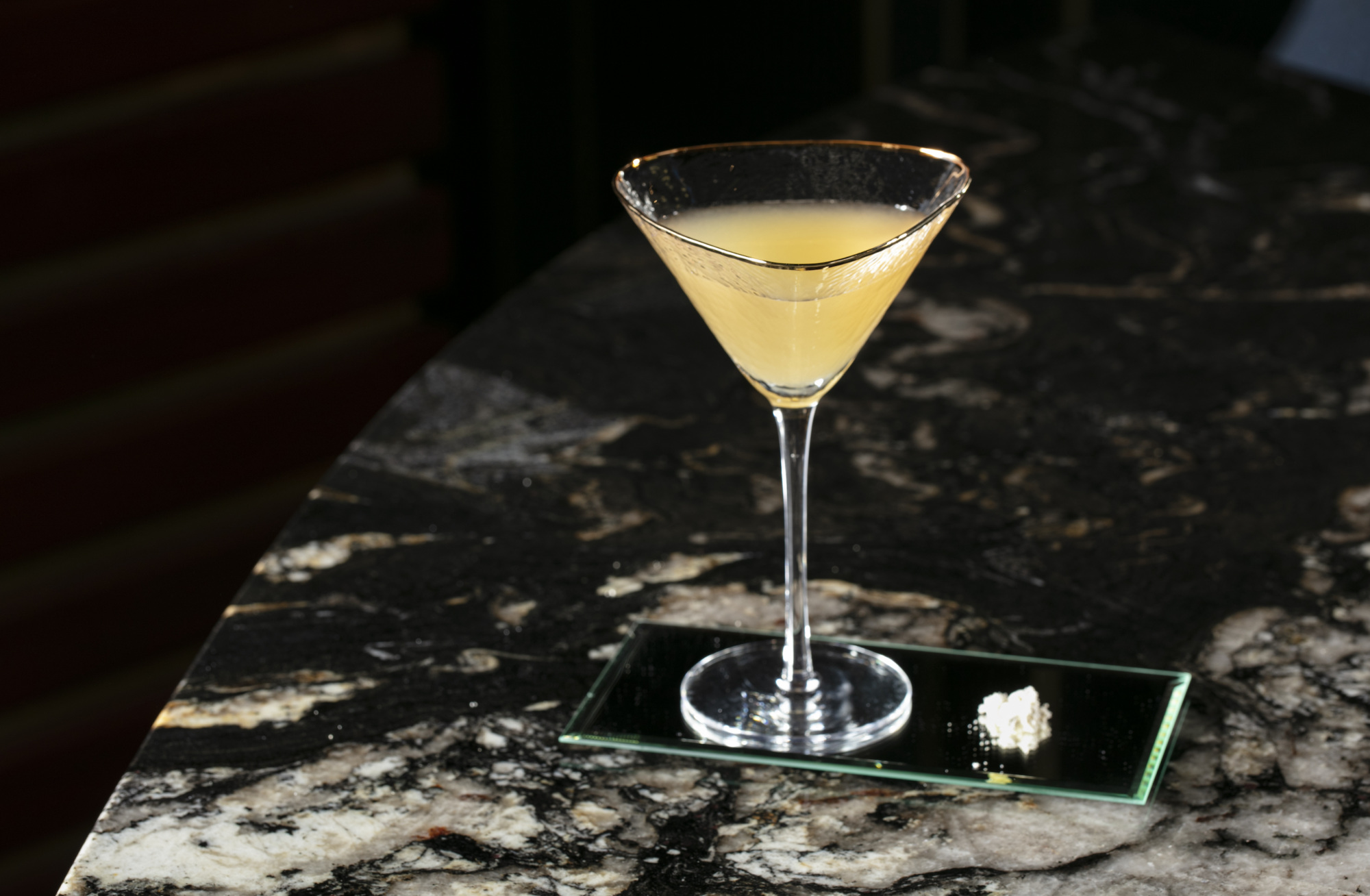
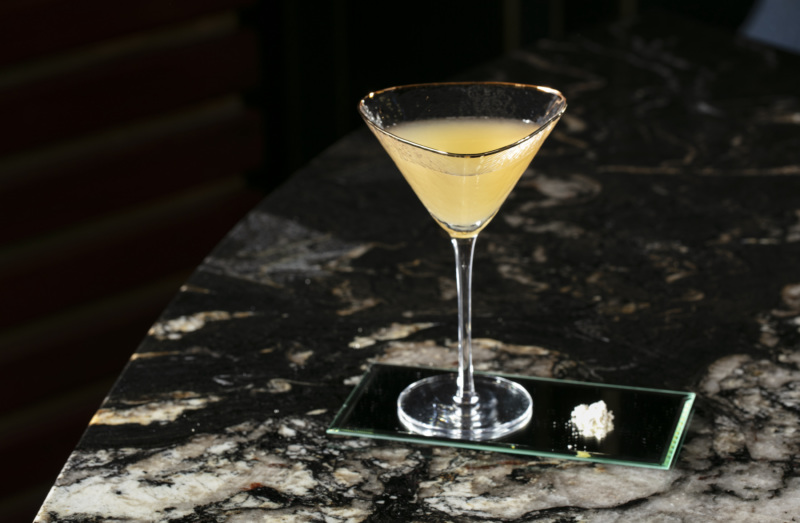
3. Dirtiest Martini
“One of my favorite cocktails on the menu is what we call the Dirtiest Martini,” says Dizard. “Dirty Martinis, for me, occupy a rather specific place in my mind: it’s about someone in their mid 20s to mid 30s, bouncing around New York nightlife, having a couple of dirty martinis and having a great time. And you know, maybe even getting into things that are slightly more illicit than a dirty martini. And so the presentation of the Dirtiest Martini is evocative of that lifestyle. The label that we had designed for this drink is based off one of the early advertising flyers for Studio 54, with a mix of the Rolling Stones mouth, licking a disco ball lollipop.
“But again, there are problems with the dirty martini. The way that the dirty martini is traditionally constructed is vodka and olive brine; olive brine is not an ingredient so much as a preservation mechanism for all of us. It was never intended to be used to make a martini. It is way overly salty. And it’s really difficult to drink more than more than two, but I can’t take more than one generally speaking, because of the salt content. So, we decided to take out the salt or to calibrate the salt to sit precisely, but then retain all the olive flavor.
“We took a single estate’s vodka from Belvedere called Smogóry Forest, and directly infuse that with freeze-dried olives to impart the flavor; it’s a very pure olive flavor not diminished by the vinegar and salt notes that you would associate specifically the dirty martini. And then we adjust that with a little bit of white soy sauce for that salinity and umami. We then take olive oil infused with gold powder and a little bit of spirulina algae, giving it a slightly greenish shimmer and from a little dropper bottle we squeeze out a liquid olive on the top of your drink which sits in a beautiful liquid-nitrogen-chilled gold rim.
“The martini glass is slightly asymmetrical in the way that you often feel after you’ve had your second martini. The drink is served on top of a mirrored coaster. And the garnish for the drink after the liquid olive is a powder that we make in house which is which is a mixture of the same freeze-dried olives, which we use to infuse the vodka powder, some olive leaf and a little bit of green Sichuan peppercorn. If you want to make the martini even dirtier, you can put this powder on your gums and it makes your gums and lips slightly numb.”

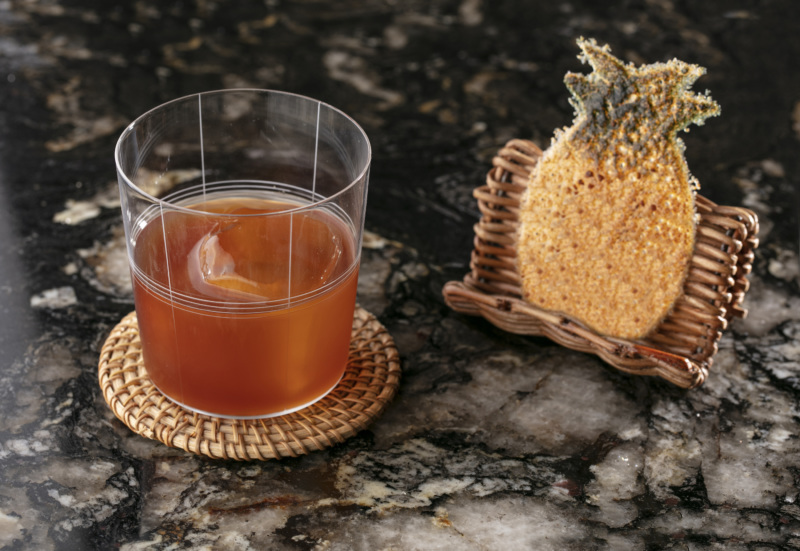
4. Soba Cha Cha Cha
“This originated as a drink that both chef Noda and Phil came up with during the pandemic,” explains Adler. “It was a shaking cocktail that was vodka infused with roasted buckwheat, or soba cha, which is a tea that we actually serve at the end of the meal, along with some pineapple, cardamom, cinnamon, and lemon juice, and it has a salt rim of sesame and soba. I thought it would be fun to turn it into a stirred drink somewhere closer to an Old Fashioned. So, after months and months and months of testing, we finally figured out how to make a vodka Old Fashioned.
“It literally tastes like it has whisky in it, but it definitely doesn’t. It has a wonderful pineapple note that’s made with a syrup made from brown sugar from Okinawa. And we also use some koji which is mold that helps turn starch into sugar so we can get all the excess starch out of the pineapple and convert it to sugar to have that pure pineapple flavor in the drink. We make a syrup with mirin caramel, with all the baking spices associated with it, such as bourbon and some bitters with red cardamom and sesame.
“But the really fun part is the garnish. I personally don’t like salt rims, only because after you take your first sip, you get a bunch of salt in your drink, and you end up chewing solids at the same time while you’re drinking the drink. So our salt rim is a little tuile that is in the shape of a pineapple. We worked with 3-D printers to create the stencil. So they’re made from isomalt as the base, which is kind of a neutral base sugar, and that gets blended with all the flavors that are inside the drinks. We bake them off and dry the fronds green with some algae and then sprinkle a little fresh roasted buckwheat on top so it has a nice textural quality. So, it’s fun to take a sip of the drink. Take a bite of your tuile that would be your salt rim, and then go back to your drink at your leisure.
“We named it the Soba Cha Cha Cha because it was a dance that was invented in Cuba. And surprisingly, soba has a very similar flavor to coffee. Now in the ‘50s when this dance and music originated, there was a big coffee drinking culture and cafes in Cuba. We love to tell stories and we thought this would be a fun story to surround the drink with. The label of the drink is a woman in a dress doing the cha cha cha.”
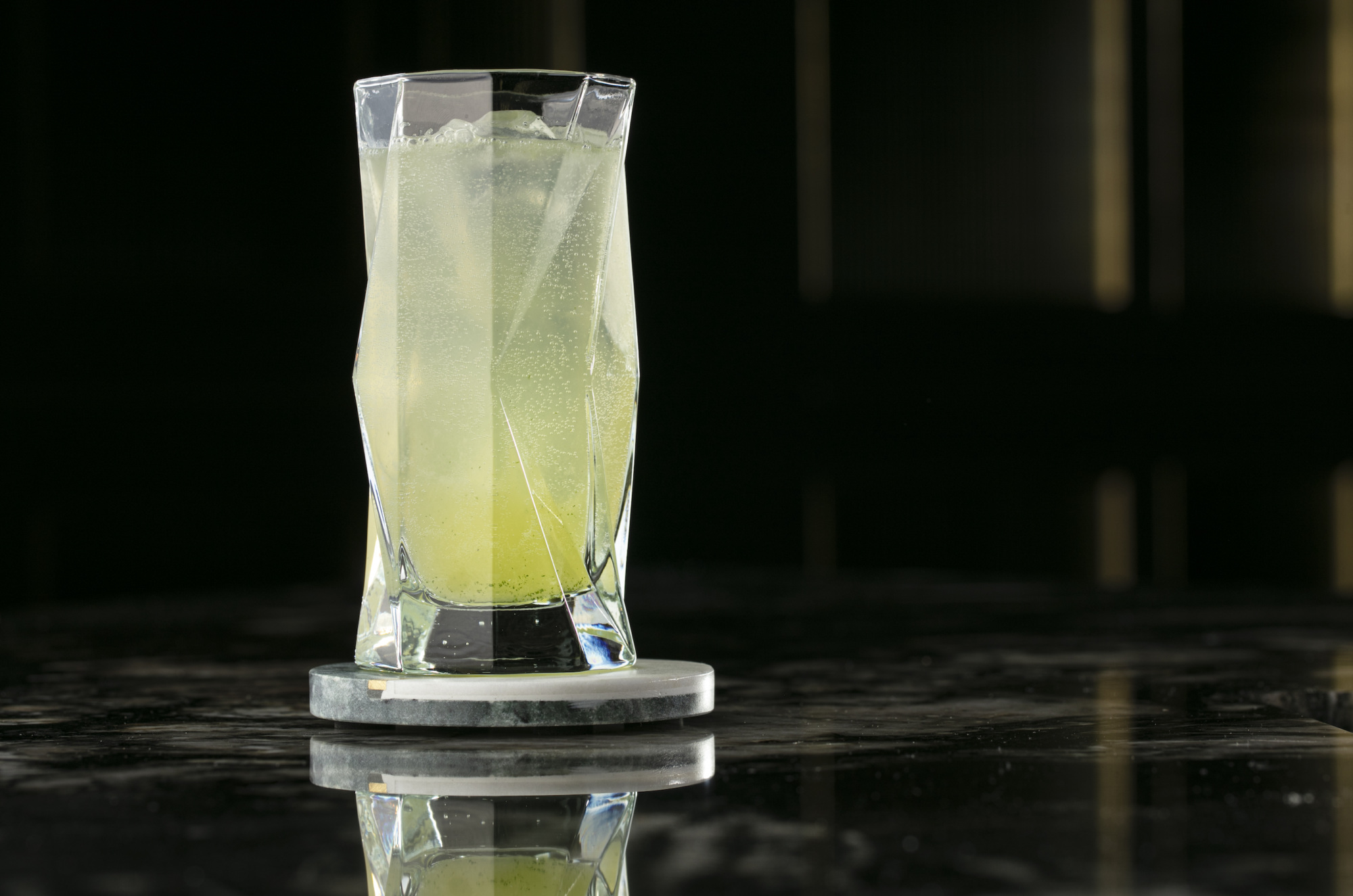
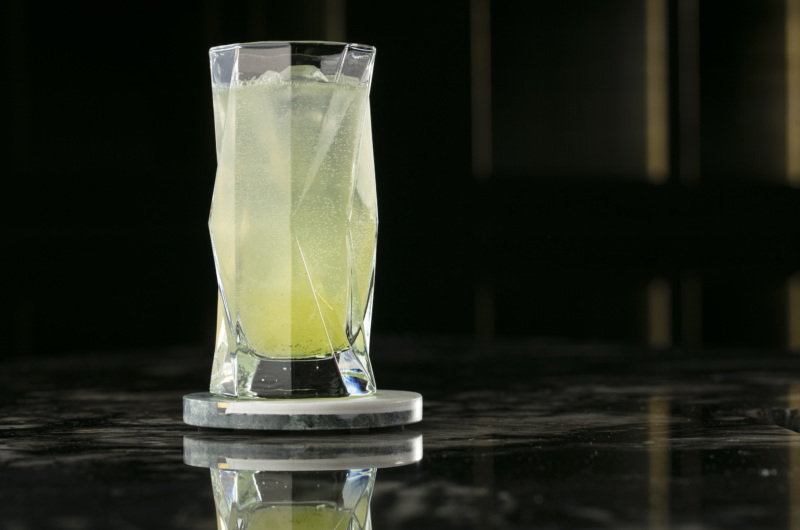
5. Shiso Mojito
“The mojito, as a drink, is problematic,” says Dizard. “That’s why you don’t see it on menus in many places. One, it’s a salad in a glass, and I’ve yet to meet the person who enjoys picking mints out of their teeth. There’s probably someone out there, but I haven’t found one yet. Two, the drink as it is, is designed to be built in the glass, but is not consistent throughout the drinking experience: No matter how much you stir it, no matter how much you integrate the ingredients into the drink, the drink will be slightly sweeter at the bottom than it is at the top. So, you’re kind of getting a short sell for the first third of your drink. Three, if you’ve ever seen the look on a bartender’s face when a six mojito call comes over the pass, you know the look of defeat in this world. It is a bar ruiner; you know, the muddling process is absurd. This is why you don’t see any mojito cocktails and cocktail bars, because bartenders hate to make those drinks but it’s an objectively delicious and foundational cocktail.
“We decided to try to address what we perceived as the core inadequacies of the cocktail. The first being there is no particulate discernible in this mojito; the drink is pre-batched and bottled and carbonated by us in house with just our shiso mint syrup and lime juice added which allows us to control both the dilution of the cocktail and the carbonation of the cocktail, but also the consistency of the dispersion of flavors throughout the cocktail. And third, the drink takes 45 seconds to make and involves no muddling whatsoever.”
Adler explains how a special vacuum maceration process allows them to create the perfect shiso mint syrup for the drink that ensures vibrancy and most of all, consistency: “Because everything is pre-batched and pre-bottled and pre-carbonated and measured out, every single guest, every single time they come there, no matter who is making that drink, will have the same exact experience.”
He adds, “We got these beautiful glasses from a company called Max ID that are produced on Long Island that are quite thick and have these really nice intricate cuts within them — they’re thick enough where we can keep the interior glass really cold without the exterior being too cold throughout to hold it. We just put two or three big pieces of ice in there so it won’t dilute the drink too quickly.”
Shinji’s is open from 5 p.m. to 1 a.m. Tuesdays through Saturdays. Reservations are highly recommended.

What to Eat and Drink in New York Right Now
Welcome back to the Resy Lineup, your biweekly dose of recommendations on what to eat, drink, and see. In this very…
Discover More

Stephen Satterfield's Corner Table















